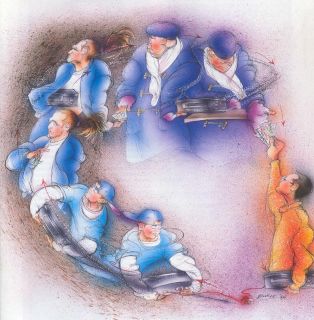|
|
Crime and the economy
I began studying stolen goods markets in response to a British Home Office study
that showed how national trends in theft rates, over many years, followed troughs in the economy. That research concluded that theft rates rose at times of economic recession because unemployment led more people to steal.
My own experience of living in high crime areas suggested that an expansion in the markets for stolen goods might follow economic troughs because vulnerable groups are more likely to buy stolen goods from existing thieves. A buoyant market for stolen goods might then fuel an increase in crime and attract new offenders to begin and continue stealing.
Over the years, my research with thieves, consumers and dealers in stolen goods has provided published detailed description and understanding of the dynamics of the stolen goods business, particualrly in terms of its impact upon theft.
The Market Reduction Approach proposes a means to tackle theft by tackling one of its root causes.
Stolen Goods Markets: Primary Research with Thieves and Buyers
Selected stolen goods and Market Reduction Approach (MRA) peer reviewed papers, articles reports and guides by Mike Sutton
|
|
Why is the subject of stolen goods markets such a neglected area?
Research has firmly established that most thieves steal in order to convert stolen property into cash, and less frequently to swap it directly for illicit drugs. If people did not buy stolen goods then the vast majority of prolific thieves would have no reason to steal them.
In 1995, estimates based on the official crime statistics, the British Crime Survey and my research revealed that thieves selling stolen property cleared between £900 million and £1.6 billion (net). Dealers in stolen goods cleared between £450 million and £870 million (net).
Nationally representative research that I conducted for the British Home Office revealed that in 1994 11 per cent of people admitted to knowingly buying stolen goods in the past five years. Nearly half of males aged 16 to 24 years of age had bought or been offered stolen goods in the past five years and 21 percent of people thought that quite a few of their neighbours owned stolen goods.

Why has the study of stolen goods markets been so neglected by criminologists?
Crime reduction experts remain fixated upon thieves and methods to reduce the vulnerability of goods while ignoring the role of the buying public in providing motivation for people to begin and continue stealing. Perhaps one important reason for this is because it is a particularly difficult area to research. I have found during the course of my 20 years of research in this area, which includes interviews with over 100 prolific thieves, that the otherwise generally law abiding buying public are reluctant to talk about their own hidden offending and thieves are cautious about revealing too much about the customers that they depend upon to convert stolen property into cash.
Perhaps the most telling question we need to ask is this one: "How many criminologists have never interviewed a single offender?"
|
|
Brief history of research into stolen goods markets and their relationship with theft
London magistrate Patrick Colquhoun (1796) examined the degree to which eighteenth century buyers of stolen goods had guilty knowledge regarding the provenance of their purchases. Noting the existence of professional Criminal Receivers as dealers in stolen goods Colquhoun also distinguished between Careless Receivers and Innocent Receivers.
The first of these three types of buyer is the most serious offender – the middleman of the theft business and knowing crime facilitator. The second type have a reckless disregard for the origin of goods – asking no questions and purchasing whatever they want that is on offer. As the name states, the last type innocently purchase stolen goods – believing them to be legitimately bought by the seller.
Years later, the important distinction between ‘professional fences’ and those who purchase stolen goods in the workplace or over the doorstep was again emphasised in Jerome Hall’s (1952) three-fold typology: the Lay Receiver – ‘one who knowingly buys stolen property for his own consumption’; the Occasional Receiver – ‘one who buys stolen property for resale but very infrequently’; the Professional Receiver – ‘the dealer in stolen goods’.
Hall’s aim was to reform the law in the United States by emphasising the role of the professional receiver in the marketing of stolen goods and his typology has been criticised because of this (Klockars, 1974):
‘…his images of lay and occasional receivers are unduly sparse and flat. They suggest nothing of the trade in stolen property among amateur thieves and dabbling dealers which thrives in bars, schools, factories and neighbourhoods.’
While 150 years before Hall’s work on complicity, Colquhoun’s description of receivers probably better described the fuller picture of the type of buyer in stolen goods markets.
What is needed, for crime reduction and other policing initiatives however is a description, based on research with thieves and buyers, that includes an understanding of complicity and is based upon systematic research into the variety of stolen goods markets and how they actually operate. This is an area in which I have been researching and publishing since 1993.
|